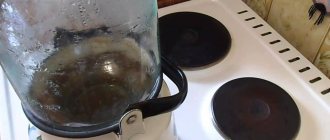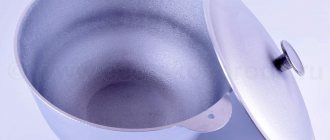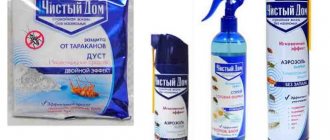The appearance of rats in the house is not only unpleasant, but also very dangerous. Therefore, when you notice the first pest, immediately start a war. “Rat Death” is recognized as an effective remedy. The drug is easy to use and ensures rapid death of tailed animals. And the instructions for using “Rat Death” will help you become familiar with the technology for exterminating rodents.
Rodents, moving around the apartment, spoil food, contaminate surfaces with their excrement, and can chew not only furniture, but also electrical wiring, which often leads to fires. But the greatest harm of tailed animals lies in their ability to endure extremely serious diseases, such as plague, hemorrhagic fever, leptospirosis, and rabies. Therefore, you should not hesitate to exterminate rats, because you are putting yourself and your family at serious risk.
How is Death of the Rat 1 different from Death of the Rat 2?
Reviews about “Death of the Rat” on the Internet are positive. There are two drugs on sale: “Rat Death 1” and “Rat Death 2”.
The difference is that the preparations contain different active rodenticidal substances:
- Brodifacoum;
- Bromadiolin.
The second is superior to brodifacoum in its toxicity to pests. Also, the funds come in different forms. The first poison is blue-green lumps, and the second looks like pieces of meat.
Danger to humans
If “Rat Death” is used correctly, it does not cause harm to humans. The drug does not release active components into the air, so the risk of “inhaling” poisons is completely eliminated. And even if you accidentally touch the poison with your hands, you will not face any negative consequences after thoroughly washing your hands with soap.
Symptoms of intoxication
Poisoning can occur only in one case - if the poison gets into the stomach. Moreover, it all depends on the dose. If a small amount of poison enters the digestive system, the liver will independently deactivate the toxin. But in the case of deliberate consumption of poison (for example, by small children), there is a threat to life. If signs of intoxication appear, be sure to seek help from a doctor. Only specialists can prevent the development of internal bleeding. The following symptoms indicate poisoning:
The antidote to the anticoagulant is the drug “Vikasol”. It is not able to neutralize Rat Death, but completely compensates for the effect of the poison. In case of minor intoxication, tablets will help; in case of severe poisoning, Vikasol is administered intravenously in a hospital setting for 15-30 days.
What to do if there was contact with poison
Even the most careful handling of the drug cannot always protect against accidental contact. If you come into contact with poison, do not panic. Take all measures to minimize the risk of intoxication. If the poison is ingested:
Do not forget that poison is dangerous not only for people, but also for animals. If your pet has ingested a dangerous drug, take it to the vet immediately. The animal will need intestinal lavage, detoxification therapy, and vitamin K injections.
Reviews of “Death of the Rat” are mostly positive. Those who have tested the poison emphasize its ease of use and high effectiveness in the fight against rodents. Many people share a way to protect children and pets from eating poison. To do this, you need to take a closed box and cut small holes in it, allowing only the rat to get inside. Briquettes are placed at the bottom. The rat will easily get in and out, and children and pets will be reliably protected from the temptation to “test their teeth.”
Video on the topic
“Rat Death” - how to get rid of rats, review
How does the product work?
It is easy to understand how the poison affects rodents by studying the composition of the drug. On the fourth day, rodents that have consumed the poison begin to experience suffocation. Internal bleeding begins. Because of it, the animal dies on the 8th day.
"Rat Death No. 1"
How to use?
In order not to leave a human smell on the poison, which can scare off a rodent, the drug is put into bags for mice using tweezers. If it is used as poison for rats, then 2-3 bags of poison will be required. It should be placed in places close to rat nests and their habitats. In residential premises, it is better to spread it along the walls every 2-15 m. For two weeks, you need to monitor the decomposed poison and replenish it where it is eaten. When the pests stop eating the poison, you can stop spreading it.
The death of rodents will occur 4 days after its consumption. 10 days is the final period for the full effect to occur.
Everything that remains after poisoning pests (remains of poison, boxes, bags), as well as their corpses, must be burned.
Why are rodents dangerous?
Pests that appear on the territory of a house or household pose a threat not only to the harvested crop, things, electrical wiring, building materials, but also to the health of the inhabitants of the house and their pets. Rats are dangerous to humans with their bites. They can cause dangerous infectious diseases, such as:
- leptospirosis;
- plague;
- rabies;
- trichinosis;
- tularemia;
- streptobacillosis.
Rats are well-organized animals. They multiply quickly, adapt well to changes in living conditions and the environment, have good sense of smell, intelligence and are able to transmit information to each other about impending danger. They recognize rat poisons and can even adapt to radiation, so it is difficult to choose the right rat poison and poison them.
All these features of pests force people to look for a more effective remedy for rats, which they cannot recognize by smell as poison. Specialists from the Italian laboratory Dr Tezza have developed a specific poison for rats, the use of which gives very good results. The drug is called Rat Death and is a powerful poison.
Precautions when using Rat Death No.1
Pregnant and lactating women, as well as adolescents under 18 years of age, should not use or come into contact with this product. People suffering from liver and blood diseases should not be present during rodent baiting work.
The drug must be used strictly according to the instructions in the instructions. Under no circumstances should you come into contact with poison with your bare hands. Do not place the product near bodies of water or places accessible to children and pets.
precautionary measures
Read on topic - The dog ate rat poison - what to do
Mode of application
Use of poison
The drug Rat Death is used to exterminate rodents by residents of private houses and by independent special teams involved in deratization. The poisonous substance is placed in plastic or cardboard containers so that they cannot be reached by pets or children.
Rat poison is placed in the most likely locations for rodents:
- near the burrows of mice and rats;
- on the path of their movement;
- along the walls of utility and living spaces.
Advantages and disadvantages of Rat Death poison
The advantage of this product is its high efficiency and availability. The poison “Rat Death” has a lot of positive consumer reviews. The death of rodents is inevitable when the pest consumes poison as food. The product has a low cost and is available for purchase to the public. The disadvantage of the poison is its toxicity. It is dangerous if it enters the gastrointestinal tract.
The downside is the fact that rodents prefer to end their life in open areas, so they crawl out of holes and die outside their shelter.
Terms of use
The instructions for use clearly describe the requirements and possibilities of using the product. It is necessary to follow the recommendations exactly. Violation of the instructions leads to negative consequences, a health problem.
- Think about where you can place the bait indoors so that rodents will immediately notice it. Prepare the required number of cardboard boxes measuring 10*10 cm. Instead of cardboard boxes, you can use a tin lid.
- Wear rubber gloves, arm yourself with a toothpick and tweezers.
- Use your tools to remove the filtered bag of poison and place it on the prepared surface. There is no need to unfold it; rodents can easily cope with this task on their own. To kill mice, add 1 briquette; rats need 2 briquettes.
- The prepared mixture of poison and additives is placed near rodent burrows, in possible places of movement. An effective location for killing mice is 2-5 m from each other. Rat baits are placed at a distance of 4-15 m.
Pests intensify their activity in the dark. In the morning you should check all the baits. Place a fresh briquette in place of the one eaten.
Use of poison
On a note!
The death of rats occurs somewhat later than that of mice. You will have to wait 1-2 weeks for the result. You can tell that the rodents have been exterminated by the appearance of the bait. If, after active devouring in the previous days, the briquette remains untouched, it means that the remedy has begun to work. Pests are dying en masse.
The remaining poison is collected in a plastic bag. Close tightly and bury in the ground to a depth of at least 0.5 m. It is strongly recommended not to throw it in trash cans, since yard dogs, cats, wild animals, and birds can detect the toxic agent. The discovered corpses of rodents should also be buried so as not to poison other animals. The disadvantages are that it is impossible to predict where a rodent will die, and getting rid of the smell of a dead rat is not so easy.
Main types of toxic substances and symptoms of poisoning
A complete list of symptoms of poisoning can only be determined depending on the type of poison that was used to make poison for the rodent. The following types of toxins can be used:
- 1st generation rodenticides;
- 2nd generation rodenticides;
- ratsid;
- vitamin D3;
- zinc phosphide.
Symptoms of a dog being poisoned by a particular group of poisons may vary. It is their determination that will help the veterinarian choose the right antidote and save the animal.
Intoxication with 1st generation rodenticides
Intoxication with 1st generation rodenticides disrupts the dog’s blood clotting process (due to impaired vitamin K synthesis).
Signs of poisoning by this group of substances are as follows:
- thirst;
- frequent urination;
- general weakness;
- decreased appetite;
- bad breath.
Intoxication with 2nd generation rodenticides
In case of poisoning with 2nd generation rodenticides, the same symptoms are observed as with substances of the first group, but with the addition of:
- urinating pink urine (a sign of impaired kidney function);
- redness of the eyes (indicates high blood pressure);
- blood with foam when coughing;
- dark stool of liquid consistency;
- black vomit;
- nosebleeds (as a result of poor blood clotting).
The first thing to appear is blood from the nose. It is this symptom that allows the owner of the animal to suspect poisoning by rat poison. The dark color of stool and vomit is due to the fact that a reaction of gastric juice and blood occurs in the body. The blood coagulates as a result of a reaction with hydrochloric acid and becomes dark in color.
The dog was poisoned by a rat
Vomiting in a dog
The main signs that a dog may have been poisoned by rats:
- cough;
- poor pulse;
- severe vomiting;
- absolute absence of urination.
Intoxication in dogs with zinc phosphide
Zinc phosphide is a strong toxin, including for the human body. It is used exclusively under the supervision of specialists for deratization. In most cases, zinc phosphide is used by specialized organizations. When zinc phosphide enters the stomach, a reaction occurs, releasing a dangerous gas. The amount of gas depends not only on the poison consumed by the dog, but also on the amount of food eaten. The gas that forms in the stomach provokes the following symptoms:
- flatulence;
- panic attacks;
- shock;
- abdominal pain;
- impaired coordination of the dog’s movements (possibly staggering when walking);
- disturbance of consciousness;
- convulsions (long-term, not eliminated by anticonvulsants).
Vitamin D3 poisoning
Vitamin D3 poisoning, at first glance, seems impossible due to its general usefulness. However, extremely high dosages are used to kill rodents. Vitamin D3 poisoning sharply increases the concentration of P and Ca in the blood, causing kidney problems and death of the animal.
Symptoms of vitamin D3 poisoning:
- bad breath;
- frequent urination;
- general weakness;
- a sharp decrease in appetite.
It should be noted that signs of vitamin poisoning appear only 2–3 days after the dog ingests the poison.
The dog's blood is taken for analysis.
Despite the wide range of symptoms of rat poisoning in dogs, diagnosing such poisoning can be quite difficult. This is due to the fact that some of the listed symptoms may be signs of other diseases, including infectious ones. When an animal consumes poison, there is a high risk of treating other diseases rather than poisoning. The most accurate way to confirm poisoning is to have your dog tested by a veterinarian.
Lethal dosage for humans
Persons who deal with rodenticides, in order to avoid disastrous consequences, must know how rat poison acts on the human body, what dosage can be fatal. The chemical has several varieties, each of which has its own dose that is life-threatening.
The condition of the human body also plays a huge role. If there are pathological processes in the liver, then the poisoning will be very strong. This is due to the fact that toxins destroy the necessary elements that are responsible for blood clotting. And the liver replenishes them.
Getting poisoned by mouse poison is quite difficult. For example, the lethal dose of Warfarin is 60 mg/kg body weight, Bromadiolone is 300 mg/kg.
Based on these figures, it can be understood that such an amount of poison can enter the body only as a result of its repeated use over a long period of time. Even mice must consume the bait within a week for them to die.
If we translate this dose into ready-made rat poison preparations, it turns out that in order for an adult to die, he needs to consume 150 g. This is a lot. Even a child needs to eat a large piece of the chemical to become poisoned. Therefore, rat poison is life-threatening only in large quantities if consumed over several days.
Poisonous substances of the drug can be poisoned not only orally. Many of them can be absorbed through the skin. That is why people who work with these chemicals must follow all safety rules (protective gloves, suit, etc.).
Causes of mice
Mice in the kitchen
Mice are dangerous pests; when they get into the house, they not only destroy food and furniture, but can also be carriers of dangerous diseases such as toxoplasmosis, leptospirosis, typhus, rabies, and tuberculosis. Rodents come to people's homes for food and warmth, enter homes through ventilation holes, technological cracks, leaking joints, cable ducts in reinforced concrete structures, and through water supply risers.
Mice usually settle in quiet places where people rarely look. Favorite places are under the bathroom, under the closet, in the pantry, under suspended ceilings, behind plasterboard panels and under baseboards.
One of the main reasons for the appearance of rodents is unsanitary conditions. Unwashed dishes, leftover food on the table, crumbs on the floor, organic garbage - all this attracts mice. They come to apartments from basements, garbage chutes and trash bins located near the house.
Additional Information! Private houses located in close proximity to cellars, barns with pets, and outbuildings in which grain is stored also attract the attention of small pests.











